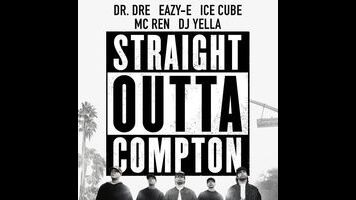Straight Outta Compton turns N.W.A.’s story into another hit-by-hit biopic

Devil’s bargains, rivalries, decadence, violence, tragedy. The story of N.W.A. is pure opera, but Straight Outta Compton, F. Gary Gray’s fitfully interesting portrayal of the group, only realizes its potential when it applies an exaggerated touch—like, say, setting the swoosh of the Universal logo to the thump-thump-thump of a police helicopter, or staging Dr. Dre’s split with Suge Knight in a smoky red boardroom divided by an open door of blinding light. Aside from these few flourishes of the outré and symbolically charged, there’s little to distinguish the movie from any number of overlong hit-by-hit music biopics of the nodding-approvingly-from-behind-a-mixing-console variety.
Money and success are generally the two least interesting things about musicians’ lives, and that goes double for gangsta rap, which sold itself partly on attitude and backstory. What this means for Straight Outta Compton is that the movie is a heck of a lot more compelling in retelling N.W.A.’s beginnings and inspirations than in outlining its assorted financial and contractual disputes, even when one takes into account the presence of Knight, a Mephistopheles figure with a knack for turning paperwork into a life-or-death situation.
Compton’s first third—which follows the group’s early years in the eponymous Los Angeles suburb—finds Gray doing his best Scorsese, complete with long, showy Steadicam and crane shots. Then comes the big money and the bad blood that goes with it, and the movie sputters into a loop of arguments over fine print and events being acknowledged in passing, none of it made any clearer by the fact that ’90s rappers’ mansions all basically looked the same. (One comes to appreciate the way Hype Williams’ Belly—a film that’s aged surprisingly well—goes out of its way to make white-walled, staircase-dominated luxury spaces look interesting.)
This is the sort of thing that’s usually carried, at least in part, by performance, and could be, if Compton’s characters were half as complicated and conflicted as the real-life personalities they represent. But the movie—produced in collaboration by Dre, Ice Cube, and Tomica Woods-Wright, widow of Eazy-E—is tactful to a fault, even as it plays up the debauchery of stardom in the gangsta rap era. It simplifies N.W.A.’s arc to a gangster-movie knock-off about three friends from way back when who are driven apart by bad influences.
These three are E (Jason Mitchell), Dre (Corey Hawkins), and Cube (the actor-rapper’s son, O’Shea Jackson, Jr., doing a good impression of what his father would be like if he had little to no screen presence). Along with perennial second bananas DJ Yella (Neil Brown, Jr.) and MC Ren (Aldis Hodge), they lead N.W.A. to unexpected chart success and help turn gangsta rap into a cultural phenomenon. (Severely Jheri-curled founding member Arabian Prince is nowhere to be seen in this version of the story.)
Originally bankrolled by E’s earnings as a drug dealer, they end up being managed by Jerry Heller (Paul Giamatti, in a bad wig for the ages), which leads to disputes over earnings, with Cube splitting for a solo career and Dre eventually decamping to Death Row Records, founded by Knight (professional stuntman R. Marcos Taylor, effectively creepy) and portrayed as a sadistic hell of Bloods red. Meanwhile, actors who look sort of like Chuck D, Tupac, and Snoop Dogg wander in and out of recording studio sets.
Gray directed the video for Ice Cube’s seminal “It Was A Good Day” and made his feature debut with the Cube-starring Friday, so he’s certainly qualified for the material. However, he’s much better at directing scenes of people listening to and enjoying music—the Steadicam gliding alongside a bouncing low rider, a staple of the era’s MTV, makes repeat appearances here—than scenes of them writing and recording it, which is a liability in a story driven by diss tracks and multi-platinum hits. It becomes one big blur of isolation booth glass, studio monitors, and thumbs-up gestures.
Every now and then, Gray and cinematographer Matthew Libatique pull out an image that’s worthy of the music, like the doozy of an opening shot, which starts with a gun being yanked out from behind a subwoofer. But for the most part, the movie has to lean on timeliness for its dramatic weight, coming at a moment when the Rodney King beating—the aftermath of which is portrayed here—seems less like history and when “Fuck Tha Police” hits harder than it has at any moment since the early ’90s. The music remains essential, even if the movie isn’t.